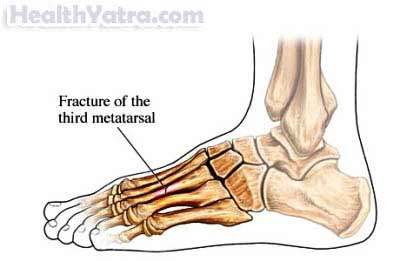परिभाषा
A march stress fracture is a small break in a foot bone which occurs without a major traumatic episode. The metatarsal bones of the foot are commonly afflicted by stress fractures. There are five metatarsal bones in each foot. They are located in the area between your toes and your ankle.

This condition can be treated. Contact your doctor if you think you may have a march stress fracture.
का कारण बनता है
A march stress fracture is an overuse injury caused by repetitive stress to the foot. In previous years these were sometimes called march fractures because they were first seen in military recruits and still do occur in that group. They are more common in certain athletic events such as running, basketball, etc.
जोखिम कारक
These factors increase your chance of a march stress fracture. Tell your doctor if you have any of these risk factors:
- Participation in high impact sports
- Running
- बास्केटबाल
- Dancing
- Soldiers
- Feet with high arches
- Poor footwear
- ऑस्टियोपोरोसिस
- Female runners with amenorrhea (absent menstruation), osteoporosis, or an eating disorder
लक्षण
If you have any of these symptoms do not assume it is due to a march stress fracture. These symptoms may be caused by other conditions. Tell your doctor if you have any of these:
- दर्द
- सूजन
- Foot feels better when resting
- Foot feels worse with activity
- लालपन
निदान
Your doctor will ask about your symptoms and medical history. A physical exam will be done. You may be referred to a specialist. An orthopedist focuses on bones. A sports medicine physician works on sport related injuries.
To search for a break in the bone the following tests may be done:
- X-ray —test that uses radiation to take pictures of structures in the body
- MRI scan —test that uses magnetic waves to form an image of structures in the body
- CT scan —type of x-ray that uses computer to form an image of structures in the body
उपचार
Stress fractures are treated with rest and nonsteroidal antiinflammatory drugs (NSAIDs). You will need to rest your foot for 3-6 weeks. Your doctor may recommend crutches for a week or two so that you don’t put any weight on your foot. Sometimes a brace or cast is used for a short time to aid healing.
Once you are able to move without pain, your doctor will allow you to return to normal activities. Gradually increase your activity over several weeks.
रोकथाम
To help reduce your chance of a stress fracture, take the following steps:
- Wear shock-absorbing insoles when running or during other high-impact exercise.
- When starting a new sport or increasing your workout, do so gradually.
- Choose footwear that takes into account the specific sport and your type of foot.
